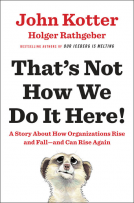
The 5 Languages of Appreciation in the Workplace
Empowering Organizations by Encouraging People
by Gary Chapman; Paul White
This title was previously available on NetGalley and is now archived.
Send NetGalley books directly to your Kindle or Kindle app
1
To read on a Kindle or Kindle app, please add kindle@netgalley.com as an approved email address to receive files in your Amazon account. Click here for step-by-step instructions.
2
Also find your Kindle email address within your Amazon account, and enter it here.
Pub Date Jan 01 2019 | Archive Date Jan 01 2019
Moody Publishers | Northfield Publishing
Talking about this book? Use #The5languagesOfAppreciationInTheWorkplace #NetGalley. More hashtag tips!
Description
OVER 600,000 COPIES SOLD!
Based on the #1 New York Times bestseller The 5 Love Languages® (over 20 million copies sold)
Dramatically improve workplace relationships simply by learning your coworkers’ language of appreciation.
This book will give you the tools to create a more positive workplace, increase employee engagement, and reduce staff turnover. How? By teaching you to effectively communicate authentic appreciation and encouragement to employees, co-workers, and leaders. Most relational problems in organizations flow from this question: do people feel appreciated? This book will help you answer “Yes!”
A bestseller—having sold over 600,000 copies and translated into 24 languages—this book has proven to be effective and valuable in diverse settings. Its principles about human behavior have helped businesses, non-profits, hospitals, schools, government agencies, and organizations with remote workers.
PLUS! Each book contains a free access code for taking the online Motivating By Appreciation (MBA) Inventory (does not apply to purchases of used books). The assessment identifies a person’s preferred languages of appreciation to help you apply the book. When supervisors and colleagues understand their coworkers’ primary and secondary languages, as well as the specific actions they desire, they can effectively communicate authentic appreciation, thus creating healthy work relationships and raising the level of performance across an entire team or organization.
**(Please contact mpcustomerservice@moody.edu if you purchased your book new and the access code is denied.)
Take your team to the next level by applying The 5 Languages of Appreciation in the Workplace.
Available Editions
| EDITION | Other Format |
| ISBN | 9780802418401 |
| PRICE | $17.99 (USD) |
| PAGES | 224 |
Featured Reviews
 Morgan S, Reviewer
Morgan S, Reviewer
I received an advanced readers copy in exchange for an honest review. This book is short and sweet but I really took a lot from it as a manager. I would recommend it to any manager attempting to build or re-structure or even just maintain a team
The Five Languages of Appreciation in the Workplace: Empowering Organizations by Encouraging People by Gary Chapman and Paul White was an advanced read I received from NetGalley. This is an updated version of this book that is the love languages translated to the workplace. I really enjoyed this one. So often we forget that there are a variety of ways to appreciate colleagues. Even more than that, we should ASK others how they want to be recognized. We each know what fills us up, and we also know what doesn't do the trick. We need to take the time to have conversations around this in the workplace to make sure people truly feel appreciation like they should. I also liked that this translated the content to remote employees. As someone who works in this way, I found these considerations particularly helpful. I'm still reflecting on this book a few days after finishing it, and I'm planning on discussing the content with some of my coworkers soon.
 Media/Journalist 81423
Media/Journalist 81423
Learning how to encourage people in the workplace is a needed thing in today’s marketplace. This title advises and lays out some good ideas.
I wish the managers at my job had the information in this book, or at least practiced it! This would turn the workplace into such a more smoothly functioning place, in addition to a less hostile place to work with mutual respect. Highly recommended!
 Tonya R, Reviewer
Tonya R, Reviewer
The 5 Languages of Appreciation in the Workplace by Gary Chapman and Paul White (originally publishes in 2012, this is the newest edition) is based off of Gary Chapman's original book The 5 Love Languages. Applying the concepts of The 5 Love Languages to work is a bit challenging but Chapman and White make it easy to relate to the examples of how to understand how people accept appreciation and respect at work.
Each person is different, but generally people will fall into one of the five areas where they accept appreciation. One of the biggest things this book accomplishes is explaining that some people just don't accept appreciation in the common business standard ways. For example, some people do not like public acknowledgement as it is very embarrassing for them. There are many examples and later in the book, challenges to overcome. The important thing is to find out how your co-workers and employees like to be shown appreciation. It shows respect and acknowledges the differences in a way that encourages diversity.
Another concern I think most employees would have going into reading a book like this is that employers would find yet another way to "motivate" employees by handing out appreciation awards in order to get them to perform better. This is definitely addressed in The 5 Languages of Appreciation in the Workplace. Overall I think it cuts through the lame reasons that employers try to manipulate and embraces the unique qualities of employees. Showing appreciation is an excellent way to keep your staff motivated and energized! Who doesn't want that?
I am thankful to Gary Chapman, Paul White, Moody Publishers, and NetGalley for an advanced review copy for me to read. My opinions are my own and no review was required with this copy.
 Reviewer 74567
Reviewer 74567
I have read Gary Chapman's other books and always found them so very helpful in the approach with people. From 5 Love Languages at Work or the original 5 Love Languages, this one was equally powerful. We do not always show Appreciation to those around us and like Love Languages we tend to only speak appreciation in our ways.
This book helps frame how you talk and receive appreciation and how to identify the way people need to be spoken to in the 5 different languages of appreciation and how to speak their language to them.
 Greg A, Reviewer
Greg A, Reviewer
For leaders who are looking forward to engaging every one in their respective organizations, this book can be of great help. The 5 Languages of Appreciation at work talks about the different ways people respond to different kinds of appreciation. Some of us feels appreciated by receiving words of affirmation while others value more the time people spend with them.
The ideas in this book will help answer the frustration of well meaning supervisors who provides encouragement to theirs demotivated employees but to no avail.
 Librarian 431790
Librarian 431790
An interesting and useful book that can be of help if you have to manage a team or just help to people to feel more motivated.
Highly recommended!
Many thanks to Moody Publishers and Netgalley for this ARC
This book was received as an ARC from Moody Publishers and Northfield Publishing in exchange for an honest review. Opinions and thoughts expressed in this review are completely my own.
Every employer must read and own a copy of this book and apply it to the workplace. This book solidifies the old proverb, if your staff is happy and treated well, they will perform to their best. People always want to feel that they love going to work so that it doesn't feel like work at all. Feeling appreciated and successful is the best feeling in the world and they will never stop talking about it with their friends and family and will enjoy what they do even more because they will have validation of their performance. This will definitely be a book that we will keep for the staff as well when times get tough.
This will definitely be considered for our Non-Fiction collection and that is why we give this book 5 stars.
 Librarian 137564
Librarian 137564
As a manager, I found this book to be both highly relevant and very useful. It's a good reminder of the many ways folks register appreciation and provides good ideas for how to recognize and appreciate those on your team who might not "speak" your own appreciation language.
 Mukesh G, Reviewer
Mukesh G, Reviewer
I had read, loved and implemented advice from the book "5 Love languages" in my personal life. It changed my relationship with both myself and my wife. So, when I picked up this book (got a free copy from NetGalley) I had very high expectaion from the book.
And to say that I am not disappointed is an understatement. The authors have done a phenomenal job of translating the framework from a personal, intimate setting to a professional setting with the same life changing possibility, for both sides of the relationship (the giver and the receiver).
Read this book if you want to do your bit to make our workplaces a much more conducive, inclusive and productive environments.. Must read for all leaders and aspiring leaders..
Thanks to the publishers and Netgalley for the Advance Review Copy.
Unlike some other reviewers I was not familiar with the other books in this series so was unable to compare them to this one. This book discusses the importance of giving and receiving appreciation in the workplace. A lot of what is contained within is common sense to anyone who works in management and leadership development but despite that, we don't often see it promoted or utilised on the ground.
The book is well researched and uses effective examples and anecdotes to exemplify its message. There are some good reflective exercises to consider at the end of each chapter which would be worthwhile for managers and supervisors in particular to consider. I thought the section on remote teams was particularly interesting (although DON'T do the electronic high fives or fist bumps - that is just cringe) as this will be more of an issue for organisations going forward as many companies move to a more flexible workforce. At work currently we are working on a project regarding this at the moment so I'll share this information with my team.
Some of the information was quite repetitive and the book would still have worked if it was a half or two thirds of its current size. Some of the language and examples was a bit cheesy in my opinion (maybe it's my British perspective) and reading about all these goody two shoes who just want appreciation instead of more money seemed a bit of a cop out sometimes and could give organisations a pass on deserved salary increases.
There is also always a danger with these books that they are preaching to the converted. All too often leaders and managers are borderline narcissistic sociopaths who don't even pretend to care about this kind of stuff and this book wont mean anything to them unfortunately.
I vehemently disagreed with almost everything in Physical Touch section. One quote in particular stood out:
"It's funny that no one hesitates to touch a baby or pat a strange dog"
Both of these are terrible ideas. Don't touch babies or dogs without permission. Don't touch people without their permission. Just don't do it.
Overall the book achieved what it set out to do and the message was generally sound: people want to be appreciated. Just don't touch them, please.
This is a must read for team leaders or managers anywhere in the world.
If you're looking for an end of year gift to your boss, this is it! I say so because we all need encouragement and more so being appreciated at work makes a whole lot of difference in how we work and this book explores both the misconceptions about appreciation and the best way to encourage and motivate people.
I got an eARC in exchange for an honest review and I loved it so much that I kept taking notes that would come in handy when I am in a leadership position.
I was delighted that someone devoted a book to the wonderful mission of appreciating employees, and there is real value in this book. Unfortunately, too much time is spent promoting the authors’ assessment tool (which costs money) which allegedly will determine the primary way any one individual wants to be acknowledged: by words, by time, by gestures, by gifts, or by touch. Additionally, large sections present dubious studies that arrive at questionable conclusions (people leave their jobs because of feeling underappreciated—really? I thought it was because they hated their boss) or boil down to common sense (guess what, sometimes people prefer help instead of being thanked). The authors seem surprised when their own simple-minded assessment doesn't capture the nuances of what people really appreciate when, instead of admitting that interactions between people are complex and can't be captured in a simple survey.
The Five Languages of Appreciation is taking the popular Five Love Languages and applying them to the workplace. There were some interesting facts that I took from this book and things that I believe I will be able to implement at work. There are valuable statistics shared about how being appreciated is the #1 factor in job satisfaction - higher than pay.
There were good examples given of how to show appreciation for Words of Affirmation, Quality Time, Acts of Service and Gifts (Physical Touch is not as relevant to the workplace though there is discussion around the debate whether to include it and the times a firm handshake or pat on the back can be appropriate). One of the most interesting parts to me was the concept of time being one of the best gifts that can be given - additional paid time off or the freedom to come late or leave early. I’ve seen the impact and excitement around this at my work but hadn’t considered it in the framework of time being so limited for everyone and that giving people time is truly a gift.
However - despite learning these things and finding ways I can apply them - this wasn’t a favorite book. I felt it was stretched out and sometimes repetitive. I think this same information could be included as a chapter in the five love languages or in a long article and not need to be a separate book.
Thank you very much to Netgalley and the publisher for a free copy in exchange for my honest review.
 Mandy P, Librarian
Mandy P, Librarian
My knowledge of the five love languages is pretty normal. I read the original book for marriages plus the one for teens. I think the main challenge in the workplace one is isolation. It takes a lot to figure out your co-workers' love languages unless your whole workplace does the inventory and shares the results (which, honestly, my personality prefers BIG TIME). The authors do give you signs to start working out the love language of those around you, but I don't know. I prefer it directly from them.
While I found some nuggets that were worth the read, I didn't really LEARN all that much from this book. I loved the initial chapters where all of the data was. (Surprise!) Once speculation began, I didn't feel it was as valuable. I liked a few of the examples - even highlighted 2 of them to share with a specific co-worker. Framing compliments as "One of the things I admire about you is...", "I wish I were more... (like them)", and being detailed and specific were all great pieces of advice.
I would recommend this to any supervisor of any kind in any field. Appreciation only means so much coming from a coworker. It tends to mean more the higher up the ladder that it comes from. However, if you're like me and searching for ways to show your colleagues that you appreciate them, it's worth a flip through - even if you have to resist the urge to make all of them take the inventory so you just know their language.
I really appreciated this book and the lessons I learned from inside the pages. I like how it really focused on the idea of building healthy workplace relationships to really make those that you lead feel valued and appreciated and even heard. Gone are the days where a person fears and has an unhealthy relationship with the boss. This book showed studies that showcase how much more productive, healthy and happy both you and your team can feel if you communicate effectively. Well written, well researched a must for all leaders or those who one day wish to become leaders.
 Jessie Y, Reviewer
Jessie Y, Reviewer
Great summation of all the love languages and how they can be used in the workplace to show appreciation. If you’re familiar with the 5 love languages this will be an easy read. It includes Generational differences in love language expression, specifics for different style work places/different industries, expressing appreciation when working with volunteers, challenges that make expressing appreciation hard and how to overcome them, Lots of examples and case studies as well as Q&A. There are thought probing questions that guide the reader to understand their language of appreciation as well as language of appreciation for their coworkers and bosses. Love how the book stresses that it’s not just bosses that should show appreciation to subordinate but that coworkers and bosses need to be shown appreciation by employees as well.
I received a digital copy of this book from netgalley. This has in no way influenced this review. I wasn’t required to write a review. All thoughts are my own.
Chapman and White’s Five Languages of Appreciation at Work is written with the same premise of some of their other works, most famously their Languages of Love. This book focuses, as the title states, in the work environment, not at home. It addresses the ways colleagues and supervisors can demonstrate appreciation to one another. The book outlines the five languages with explanations and examples. It provides data and facts to support the notions that showing appreciation is key if it is done in a way that actually matches the way a person wants to be appreciated. The authors have created an inventory to allow individuals to identify and classify their appreciation method. Once known, it can be shared and explored, so people can get the accolades they deserve, in a way that will feel sincere and valid. The authors also acknowledged that knowing about appreciation types is helpful but not foolproof, and sometimes just knowing one’s appreciation style is not enough. They share strategies that address scenarios and situations when more is needed or miscommunication may have occurred. I appreciate the honesty in acknowledging this aspect of the dynamic.
Overall, I think anyone who works in a group setting and cares about being appreciated in a way that makes sense to them (I know this is not everyone), will benefit from taking the inventory and reading the book. Though I received a digital copy to review, I went out and bought a hard copy and inventory, as I want to show it to my coworkers and perhaps integrate it fully in my work setting.
 Amanda E, Reviewer
Amanda E, Reviewer
I have long been an advocate for applying the five love languages into relationships. Even before I knew that the 5 Languages of Appreciation in the Workplace book existed, I've had conversations with co-workers about how you could apply these languages in the workplace. Therefore, I was delighted to find out that there was actually a book dedicated to this topic and knew I had to read it. I truly believe that these languages exist and could really make a difference in the happiness level of workers if they were applied by supervisors and coworkers alike. Although the book feels like it was written for supervisors or managers to read, I felt like anyone who is working could apply these practices with their fellow co-workers. After all, the "worker bees" tend to interact more frequently with one another than with their supervisors and would have more opportunities to express appreciation. My only complaint about the book is that I felt like it was a little repetitive and long winded. It could probably be condensed into a couple of chapters or written as a long magazine article. Despite this drawback, it is still worth reading. Maybe all the repetition helps the ideas sink into the reader better! I've read two other 5 Love Languages books so maybe it wouldn't be as redundant for first time readers of the 5 Love Languages concept. Thanks to NetGalley for a copy of this book. All thoughts expressed in this review are my honest opinions of this book.
 T V, Reviewer
T V, Reviewer
Better for New Adherents to Love Languages
February 10, 2019
As much as the premise is compelling, and the research powerful in its own right, the text was slow, plodding, and difficult to read in digital format. Pull quotes showed up in color mid-sentence, with no delineation as to why (in my copy). People who may have read about love languages for a previous application may find this book merely repeats the concepts for about 1/2 the book, before going way deep, way fast, about why workplaces require a slightly different interpretation of the standard five love languages. For my library, it’s extraneous.
 Megan D, Reviewer
Megan D, Reviewer
This revision to the 5 Languages of Appreciation in the Workplace was great, though I'm not sure how different it was from the original. As before, I liked that this book focused on everyone in the workplace contributing to appreciation, not just managers and supervisors. I think it's an important concept that we all contribute to the work environments we are a part of. It might be that I read the other so long ago that I don't easily recognize the differences. Regardless, rereading the book and reminding myself of the theories within is a great reminder!
 Dustin H, Reviewer
Dustin H, Reviewer
Gary Chapman's work has been influential to millions of people. He improved the way couples communicate and talk to one another. Now he's revolutionized how we interact with people in our workplace. Our workplace happiness is equally important as our home, but sometimes handling conflicts can be much for challenging. This book makes handling these conflicts much easier and creating a work environment that allows you to treat co-workers like an extended family. This is a must-read for leaders in the business world.
 Ann T, Reviewer
Ann T, Reviewer
Thank you Moody Publishers and Netgalley for this ARC.
I have read the ‘Five Love Languages’ and the ‘Five Love Languages for Children ‘ and still, years later highly recommend them to people.
This book will also be added to that list now !! Again, Mr Chapman and Mr White present easily readable information on how people have different work styles. It is a highly informative, common sense book for all leaders, and team members to read and embrace.
Readers who liked this book also liked:
John Kotter; Holger Rathgeber
Business, Leadership, Finance, Nonfiction (Adult)


















